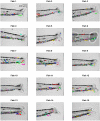The neutrophil's eye-view: inference and visualisation of the chemoattractant field driving cell chemotaxis in vivo
- PMID: 22563379
- PMCID: PMC3338515
- DOI: 10.1371/journal.pone.0035182
The neutrophil's eye-view: inference and visualisation of the chemoattractant field driving cell chemotaxis in vivo
Abstract
As we begin to understand the signals that drive chemotaxis in vivo, it is becoming clear that there is a complex interplay of chemotactic factors, which changes over time as the inflammatory response evolves. New animal models such as transgenic lines of zebrafish, which are near transparent and where the neutrophils express a green fluorescent protein, have the potential to greatly increase our understanding of the chemotactic process under conditions of wounding and infection from video microscopy data. Measurement of the chemoattractants over space (and their evolution over time) is a key objective for understanding the signals driving neutrophil chemotaxis. However, it is not possible to measure and visualise the most important contributors to in vivo chemotaxis, and in fact the understanding of the main contributors at any particular time is incomplete. The key insight that we make in this investigation is that the neutrophils themselves are sensing the underlying field that is driving their action and we can use the observations of neutrophil movement to infer the hidden net chemoattractant field by use of a novel computational framework. We apply the methodology to multiple in vivo neutrophil recruitment data sets to demonstrate this new technique and find that the method provides consistent estimates of the chemoattractant field across the majority of experiments. The framework that we derive represents an important new methodology for cell biologists investigating the signalling processes driving cell chemotaxis, which we label the neutrophils eye-view of the chemoattractant field.
Conflict of interest statement
Figures


 1000 pixels has been zoomed on the vertical axis to the 100–900 pixel range.
1000 pixels has been zoomed on the vertical axis to the 100–900 pixel range.

 m/min range for an effective visualisation and data are aggregated over all fish). B: Histogram of neutrophil velocities in the Y-direction.
m/min range for an effective visualisation and data are aggregated over all fish). B: Histogram of neutrophil velocities in the Y-direction.

Similar articles
-
Resolution of inflammation by retrograde chemotaxis of neutrophils in transgenic zebrafish.J Leukoc Biol. 2006 Dec;80(6):1281-8. doi: 10.1189/jlb.0506346. Epub 2006 Sep 8. J Leukoc Biol. 2006. PMID: 16963624
-
Tracking neutrophil intraluminal crawling, transendothelial migration and chemotaxis in tissue by intravital video microscopy.J Vis Exp. 2011 Sep 24;(55):3296. doi: 10.3791/3296. J Vis Exp. 2011. PMID: 21968530 Free PMC article.
-
Fer kinase limits neutrophil chemotaxis toward end target chemoattractants.J Immunol. 2013 Mar 1;190(5):2208-16. doi: 10.4049/jimmunol.1200322. Epub 2013 Jan 25. J Immunol. 2013. PMID: 23355730 Free PMC article.
-
Neutrophil chemotaxis.Cell Tissue Res. 2018 Mar;371(3):425-436. doi: 10.1007/s00441-017-2776-8. Epub 2018 Jan 19. Cell Tissue Res. 2018. PMID: 29350282 Review.
-
In the eye of the neutrophil swarm-navigation signals that bring neutrophils together in inflamed and infected tissues.J Leukoc Biol. 2016 Jul;100(1):55-63. doi: 10.1189/jlb.1MR0915-403. Epub 2015 Sep 28. J Leukoc Biol. 2016. PMID: 26416718 Review.
Cited by
-
Cxcl8 (IL-8) mediates neutrophil recruitment and behavior in the zebrafish inflammatory response.J Immunol. 2013 Apr 15;190(8):4349-59. doi: 10.4049/jimmunol.1203266. Epub 2013 Mar 18. J Immunol. 2013. PMID: 23509368 Free PMC article.
-
Macrosight: A Novel Framework to Analyze the Shape and Movement of Interacting Macrophages Using Matlab®.J Imaging. 2019 Jan 14;5(1):17. doi: 10.3390/jimaging5010017. J Imaging. 2019. PMID: 34465701 Free PMC article.
-
PhagoSight: an open-source MATLAB® package for the analysis of fluorescent neutrophil and macrophage migration in a zebrafish model.PLoS One. 2013 Aug 30;8(8):e72636. doi: 10.1371/journal.pone.0072636. eCollection 2013. PLoS One. 2013. PMID: 24023630 Free PMC article.
-
Inflammatory, Oxidative Stress, and Apoptosis Effects in Zebrafish Larvae after Rapid Exposure to a Commercial Glyphosate Formulation.Biomedicines. 2021 Nov 27;9(12):1784. doi: 10.3390/biomedicines9121784. Biomedicines. 2021. PMID: 34944599 Free PMC article.
-
The niche-derived glial cell line-derived neurotrophic factor (GDNF) induces migration of mouse spermatogonial stem/progenitor cells.PLoS One. 2013 Apr 22;8(4):e59431. doi: 10.1371/journal.pone.0059431. Print 2013. PLoS One. 2013. PMID: 23613711 Free PMC article.
References
-
- Porter SL, Wadhams GH, Armitage JP. Signal processing in complex chemotaxis pathways. Nature Reviews Microbiology. 2011;9:153–165. - PubMed
-
- Parent CA. Making all the right moves: chemotaxis in neutrophils and dictyostelium. Current Opinion in Cell Biology. 2004;16:4–13. - PubMed
-
- Nathan C. Neutrophils and immunity: challenges and opportunities. Nature Reviews Immunology. 2006;6:173–182. - PubMed
-
- Silva MT. Macrophage phagocytosis of neutrophils at inammatory/infectious foci: a cooperative mechanism in the control of infection and infectious inammation. Journal of Leukocyte Biology. 2011;89:675–683. - PubMed
Publication types
MeSH terms
Substances
Grants and funding
LinkOut - more resources
Full Text Sources
Molecular Biology Databases
Research Materials

